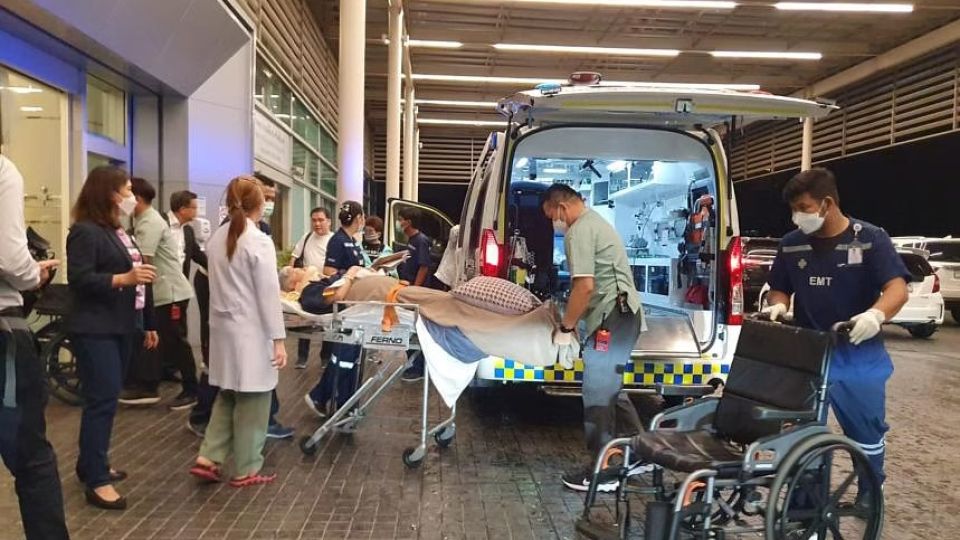May 29, 2024
BANGKOK – It began with an emergency call on May 21 requesting Bangkok’s Samitivej Srinakarin Hospital to take in about 20 injured passengers from nearby Suvarnabhumi Airport.
But every few minutes, the number would climb.
Eventually, the private hospital would provide medical care for 104 patients who were on board Singapore Airlines’ turbulence-hit Flight SQ321 after it made an emergency landing in Bangkok in the late afternoon.
“Once I got the activation call, we had only about 15 minutes to get ready, and the first ambulance arrived at the hospital shortly after,” said Dr Saran Intakul, deputy director of Samitivej Srinakarin Hospital, who commanded the hospital’s response to the incoming patients from the flight.
With some 20 doctors, 50 nurses and dozens of other medical staff, the hospital got to work assessing patients arriving in a stream of ambulances, before sending them to the relevant departments for treatment.
“The worst injuries included bleeding from the head, spinal injuries and possible paralysis,” said the hospital’s trauma director, Dr Krittanai Thangsakul, who was in charge of treating patients with the most severe injuries.
Meanwhile, the hospital also alerted several back-up medical teams – including general surgeons and spinal specialists – and the blood bank to be on standby.
SQ321, which was heading to Singapore from London, experienced sudden extreme turbulence on May 21 over the Irrawaddy Basin in Myanmar.
Information gathered from flight tracking site Flightradar24 shows the Boeing 777-300ER rapidly climbing and dropping in the air within a matter of seconds.
Passengers on board were flung violently in the cabin, with some thrown off their seats or even hitting the baggage cabins above them.
A 73-year-old British passenger died of a suspected heart attack, while dozens were injured.
The pilot declared a medical emergency, and diverted the plane carrying 211 passengers and 18 crew members to make an emergency landing at Suvarnabhumi Airport at 3.45pm.
For the next 24 hours, medical workers at Samitivej Srinakarin Hospital, which admitted the bulk of the affected passengers, worked in shifts, tending to at least 10 critical cases while performing a total of nine operations that day.
“It was a crazy day, but it also shows that our hospital can handle such a mass casualty event successfully,” said Dr Saran.
The hospital takes part in yearly mass casualty drills together with the authorities and other hospitals, and its Samitivej Trauma Centre is specifically equipped to handle all kinds of emergencies and critical conditions.
This is not the hospital’s first time caring for passengers injured due to extreme turbulence.
In 2017, the hospital helped to treat several passengers from an Aeroflot flight that hit a patch of severe turbulence during its flight from Moscow to Bangkok. Twenty-seven people were injured, with some suffering broken bones and needing surgery.
Last week’s incident was on a much larger scale, said Dr Saran, noting that the patients from SQ321 ranged from ages two to 83.
In an update on May 28, SIA said 28 people remain hospitalised in Bangkok.
While all patients at Samitivej are in stable condition, Dr Krittanai said that the road to recovery could be weeks, or even years for some, especially for those who suffered severe spinal injuries or went through major operations.
Several patients are also still undergoing physical rehabilitation and will likely have to seek follow-up treatment even if they are discharged, he added.
Dr Saran said the hospital is working with SIA regarding repatriation arrangements for its patients through commercial flights or air ambulances, if needed.
Besides treating the physical injuries, the hospital has also put together a team of psychiatrists to help patients who are experiencing emotional distress following the traumatic incident.
This includes providing medication, therapy and simulating the in-plane experience to prepare them for the eventual boarding of their flight home.
While a week has passed since the incident, Dr Krittanai said it is understandable that patients still feel scared or worried due to what they have gone through.
“So it is encouraging to see that some are visibly less anxious and they tell us that they feel safe,” he added. “They have also thanked us for our treatment and care.”


